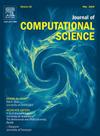Fast and power efficient GPU-based explicit elastic wave propagation analysis by low-ordered orthogonal voxel finite element with INT8 Tensor Cores
IF 3.7
3区 计算机科学
Q2 COMPUTER SCIENCE, INTERDISCIPLINARY APPLICATIONS
引用次数: 0
Abstract
There is a strong need for faster and more power-efficient explicit elastic wavefield simulations for large and complex three-dimensional media using a structured finite element method. Such wavefield simulations are suitable for GPUs, which have been improving their computational performance in recent years, and the use of GPUs is expected to speed up such simulations. However, there is still room for speedup and improving energy efficiency of such simulations using GPUs, since the performance of GPUs is not fully exploited just by its simple use, and the conventional method involves some numerical dispersion. In this paper, we propose a method for fast and efficient explicit structured-mesh wavefield simulation on GPUs by utilizing INT8 Tensor Cores and reducing numerical dispersion. We implemented the proposed method on GPUs and evaluated its performance in detail using an application example that simulates a real problem, and showed that it is faster and more efficient than conventional methods on many-node CPU-based systems and multiple GPU-based systems. This paper is the extended version of Ichimura et al. (2024).[1]
基于INT8张量核低阶正交体素有限元的快速高效gpu显式弹性波传播分析
对于大型复杂的三维介质,迫切需要采用结构有限元法进行更快、更节能的显式弹性波场模拟。这种波场模拟适合gpu,近年来gpu的计算性能一直在提高,gpu的使用有望加快这种模拟。然而,由于gpu的简单使用并不能充分发挥其性能,并且传统方法涉及到一些数值色散,因此使用gpu进行此类模拟仍有加速和提高能效的空间。本文提出了一种利用INT8张量核和减少数值色散的方法,在gpu上实现快速高效的显式结构网格波场模拟。我们在gpu上实现了该方法,并通过一个模拟实际问题的应用实例对其性能进行了详细的评估,结果表明,该方法在基于多节点cpu的系统和基于多gpu的系统上比传统方法更快、更高效。本文是Ichimura et al. (2024). b[1]的扩展版
本文章由计算机程序翻译,如有差异,请以英文原文为准。
求助全文
约1分钟内获得全文
求助全文
来源期刊

Journal of Computational Science
COMPUTER SCIENCE, INTERDISCIPLINARY APPLICATIONS-COMPUTER SCIENCE, THEORY & METHODS
CiteScore
5.50
自引率
3.00%
发文量
227
审稿时长
41 days
期刊介绍:
Computational Science is a rapidly growing multi- and interdisciplinary field that uses advanced computing and data analysis to understand and solve complex problems. It has reached a level of predictive capability that now firmly complements the traditional pillars of experimentation and theory.
The recent advances in experimental techniques such as detectors, on-line sensor networks and high-resolution imaging techniques, have opened up new windows into physical and biological processes at many levels of detail. The resulting data explosion allows for detailed data driven modeling and simulation.
This new discipline in science combines computational thinking, modern computational methods, devices and collateral technologies to address problems far beyond the scope of traditional numerical methods.
Computational science typically unifies three distinct elements:
• Modeling, Algorithms and Simulations (e.g. numerical and non-numerical, discrete and continuous);
• Software developed to solve science (e.g., biological, physical, and social), engineering, medicine, and humanities problems;
• Computer and information science that develops and optimizes the advanced system hardware, software, networking, and data management components (e.g. problem solving environments).
 求助内容:
求助内容: 应助结果提醒方式:
应助结果提醒方式:


